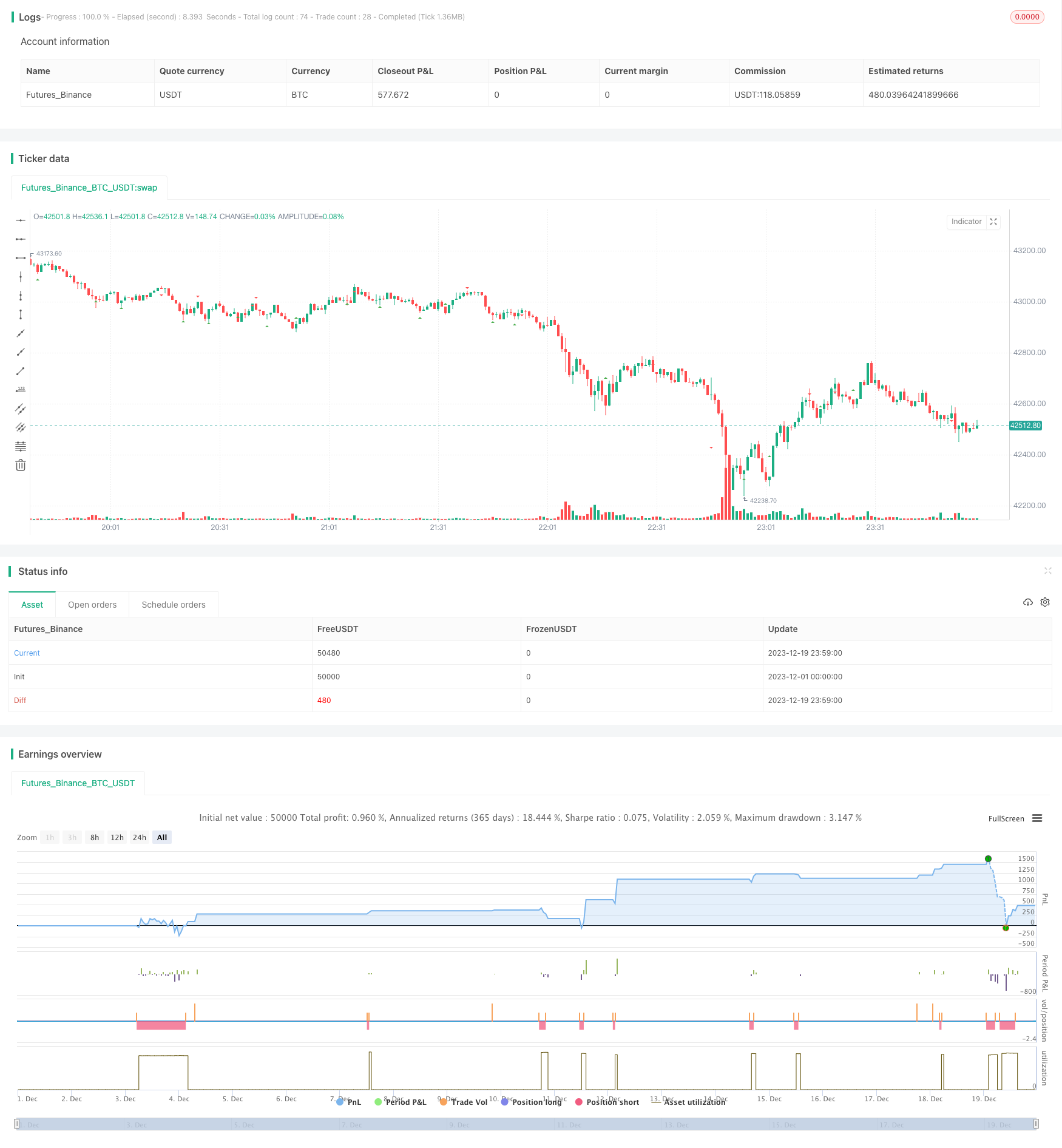Automatischer Trend basierend auf Pivot Point und Fibonacci Retracement nach Strategie
Schriftsteller:ChaoZhang, Datum: 2024-01-05 11:34:17Tags:

Übersicht
Diese Strategie identifiziert automatisch ABC-Muster in Aktienkursen basierend auf Drehpunkten und Fibonacci-Retracement-Verhältnissen und erzeugt Long/Short-Signale. Sie verwendet Drehpunkte, um Preiswellen zu bestimmen und berechnet Fibonacci-Retracement-Verhältnisse zwischen ABC-Wellen. Wenn die Verhältnisse bestimmte Kriterien erfüllen, werden Handelssignale generiert.
Strategie Logik
- Berechnen Sie die Pivot-Hoch- und Tiefpunkte der Aktie
- Beurteilen, ob der Preis vom vorherigen Höchststand zurückgegangen ist oder vom vorherigen Tiefstand gestiegen ist
- Berechnen Sie die Fibonacci-Retracement-Verhältnis zwischen der aktuellen Welle und der vorherigen Welle
- Wenn die Rückzugsquoten der beiden Auf- und Abwellen innerhalb der richtigen Grenzen liegen, bestimmt man ein mögliches ABC-Muster
- Nach der Bestätigung des ABC-Musters setzen Sie den Stop-Loss auf Punkt C für lang und auf Punkt A für kurz.
Analyse der Vorteile
- Pivotpunkte identifizieren wichtige Unterstützungs-/Widerstandsniveaus zur Verbesserung der Signalgenauigkeit
- Fibonacci-Retracements fangen Trendwendepunkte auf, indem sie ABC-Muster identifizieren
- Klarer Gewinn-Verlust-Ansatz verhindert große Verluste
Risikoanalyse
- Pivotpunkte und Fibonacci-Retracements können nicht die perfekte Identifizierung aller Trendwendepunkte gewährleisten.
- Punkt C und Punkt A können durchbrochen werden, was zu größeren Verlusten führt
- Parameter wie Fibonacci-Retracement-Ratio-Bereiche müssen weiter optimiert werden
Optimierungsrichtlinien
- Mehr technische Indikatoren zur Unterstützung der Bestätigung von ABC-Mustern, um die Signalgenauigkeit zu verbessern
- Optimieren Sie die Fibonacci-Retracement-Reihe für mehr Marktbedingungen
- Verwenden von Methoden des maschinellen Lernens zur Ausbildung von ABC-Mustererkennungsmodellen
Schlussfolgerung
Diese Strategie identifiziert ABC-Muster für die Erzeugung von Long/Short-Signalen an Trend-Wendepunkten, basierend auf der Pivot-Point-Bestätigung der wichtigsten Unterstützungs-/Widerstandsniveaus und Fibonacci-Retracement-Ratio-Berechnungen.
/*backtest
start: 2023-12-01 00:00:00
end: 2023-12-19 23:59:59
period: 1m
basePeriod: 1m
exchanges: [{"eid":"Futures_Binance","currency":"BTC_USDT"}]
*/
// This source code is subject to the terms of the Mozilla Public License 2.0 at https://mozilla.org/MPL/2.0/
// © kerok3g
//@version=5
strategy("ABCD Strategy", shorttitle="ABCDS", overlay=true, commission_value=0.04)
calcdev(fprice, lprice, fbars, lbars) =>
rise = lprice - fprice
run = lbars - fbars
avg = rise/run
((bar_index - lbars) * avg) + lprice
len = input(5)
ph = ta.pivothigh(len, len)
pl = ta.pivotlow(len, len)
var bool ishigh = false
ishigh := ishigh[1]
var float currph = 0.0
var int currphb = 0
currph := nz(currph)
currphb := nz(currphb)
var float oldph = 0.0
var int oldphb = 0
oldph := nz(oldph)
oldphb := nz(oldphb)
var float currpl = 0.0
var int currplb = 0
currpl := nz(currpl)
currplb := nz(currplb)
var float oldpl = 0.0
var int oldplb = 0
oldpl := nz(oldpl)
oldplb := nz(oldplb)
if (not na(ph))
ishigh := true
oldph := currph
oldphb := currphb
currph := ph
currphb := bar_index[len]
else
if (not na(pl))
ishigh := false
oldpl := currpl
oldplb := currplb
currpl := pl
currplb := bar_index[len]
endHighPoint = calcdev(oldph, currph, oldphb, currphb)
endLowPoint = calcdev(oldpl, currpl, oldplb, currplb)
plotshape(ph, style=shape.triangledown, color=color.red, location=location.abovebar, offset=-len)
plotshape(pl, style=shape.triangleup, color=color.green, location=location.belowbar, offset=-len)
// var line lnhigher = na
// var line lnlower = na
// lnhigher := line.new(oldphb, oldph, bar_index, endHighPoint)
// lnlower := line.new(oldplb, oldpl, bar_index, endLowPoint)
// line.delete(lnhigher[1])
// line.delete(lnlower[1])
formlong = oldphb < oldplb and oldpl < currphb and currphb < currplb
longratio1 = (currph - oldpl) / (oldph - oldpl)
longratio2 = (currph - currpl) / (currph - oldpl)
formshort = oldplb < oldphb and oldphb < currplb and currplb < currphb
shortratio1 = (oldph - currpl) / (oldph - oldpl)
shortratio2 = (currph - currpl) / (oldph - currpl)
// prevent multiple entry for one pattern
var int signalid = 0
signalid := nz(signalid[1])
longCond = formlong and
longratio1 < 0.7 and
longratio1 > 0.5 and
longratio2 > 1.1 and
longratio2 < 1.35 and
close < oldph and
close > currpl and
signalid != oldplb
if (longCond)
signalid := oldplb
longsl = currpl - ta.tr
longtp = ((close - longsl) * 1.5) + close
strategy.entry("Long", strategy.long)
strategy.exit("Exit Long", "Long", limit=math.min(longtp, oldph), stop=longsl)
shortCond = formshort and
shortratio1 < 0.7 and
shortratio1 > 0.5 and
shortratio2 > 1.1 and
shortratio2 < 1.35 and
close > oldpl and
close < currph and
signalid != oldphb
if (shortCond)
signalid := oldphb
shortsl = currph + ta.tr
shorttp = close - ((shortsl - close) * 1.5)
strategy.entry("Short", strategy.short)
strategy.exit("Exit Short", "Short", limit=math.max(shorttp, oldpl), stop=shortsl)
Mehr
- Trend nach der Handelsstrategie des gleitenden Durchschnitts
- Trend nach der Momentum-Breakout-Strategie
- Breakout- und Intelligente Bollinger-Bänder-Preiskanalestrategie
- Einfacher Trend nach Strategie
- Langfristige Durchbruchstrategie auf der Grundlage des K-Line-Baus
- Momentum Oscillierender gleitender Durchschnittshandelsstrategie auf der Grundlage von gepufferten Bollinger Bands
- Adaptive Backtest-Datumsbereichsauswahlstrategie auf der Grundlage von Doppel-MA
- Multi-Timeframe Moving Average Crossover Optimierungsstrategie
- Strategie zur Nachverfolgung von Durchbrüchen
- Anpassungsfähige Handelsstrategie auf Basis von Momentumindikatoren
- Trend-Nachfolge-Strategie auf Basis von EMA und MACD über Zeiträume
- Strategie zur Umkehrung der Kollision mit mehreren Indikatoren
- Trendumkehrstrategie auf Basis von EMA- und SMA-Kreuzung
- DMI-DPO-Sicherheitsstrategie
- Kurzfristige Handelsstrategie zur Trendverfolgung
- RSI-Trend nach der Bullenstrategie
- Strategie zur Kombination von RSIndex und gleitendem Durchschnitt
- Multi-Zeitrahmen-MA-Trend nach Strategie
- Doppelindikatoren Bottom-Buy-Strategie
- Die Strategie zur Umkehrung der "Bearish Engulfing"-Strategie